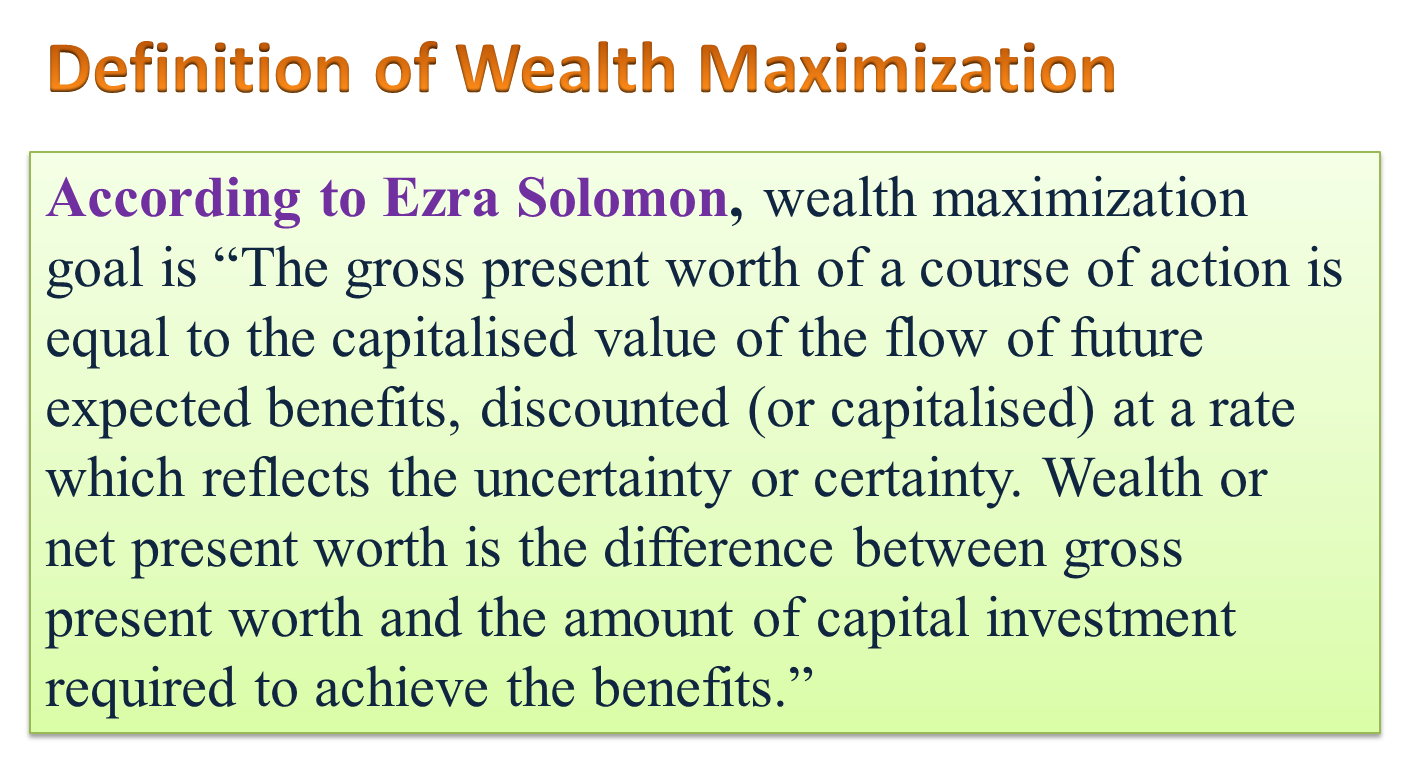Wealth maximization is also known as Value Maximization or net Present Worth Maximization. Wealth maximization has all the features of certainty, quality benefits, and timing benefits. The goal of wealth maximization is the widely accepted goal of the business as it reconciles the varied, often conflicting interest of the stakeholders. Also, it is free from the limitations that other objectives are faced with.

Shareholders being the true owners of the firm are entitled to the residual profit only. After meeting the commitment to all other stakeholders they get the remaining. Shareholders claim cannot precede that of any other stakeholders. Thus, by maximization of residual as the objective of the firm, it can safely be stated that all preceding commitments have been adequately satisfied. Pursuit of these all-encompassing goals by the firm ensures that the interest of all the different stakeholders is taken care of in the process as this wealth maximization as a goal is in congruence with the objectives of the varied stakeholders. No firm can bring about sustained increase in the wealth of its owners without taking care of the interest of its other stakeholders. For example, the deteriorating liquidity position of a firm makes the lenders, current and prospective, worried about its creditworthiness, which eventually gets reflected in its share prices and consequently the wealth of the shareholders. Similarly, a firm that cannot retain its existing customers will witness a decline in its sales and consequently the market price of shares. The wealth maximization approach can he more explicitly defined in the following ways:
\[W=\frac{{{A}_{1}}}{{{\left( 1+K \right)}^{1}}}+\frac{{{A}_{2}}}{{{\left( 1+K \right)}^{2}}}+….+\frac{{{A}_{n}}}{{{\left( 1+K \right)}^{n}}}-C\]
\[W=\sum\limits_{t=1}^{n}{\frac{{{A}_{t}}}{{{\left( 1+K \right)}^{t}}}}-C\]
Where,
W = Net present worth
A1, A2, …… An = Streams of benefits expected/Future cash flows
C = Cash outlay or cost of action/Cost of project
K = Discount rate/Capitalization rate
Features of Wealth Maximization
Wealth maximization criterion has a far and wide range of acceptance because of its following salient features:
- The idea and notion of wealth is distinct and simple to understand.
- It serves as an important aid to investment decisions.
- It refers to the time adjusted present value of benefits, thereby reducing the cost of investment.
- Maximizing economic well being of its shareholder is one of the parameters of wealth maximization.
- Wealth maximization takes into concern both the quantity and quality standards of benefits.
- It also integrates the time value of money, risk and uncertainty factors.
- It considers that the shareholder’s wealth is maximized only when the market price per share is maximized.
- It also avoids agency issues in an organization, as it encompasses the personal goals of executives, such as recognition, power, status, personal wealth, etc.
- It eliminates the associated limitations of the profit maximization objective of financial management.
Arguments in Favour of Wealth Maximization
The following arguments can be given in favor of wealth maximization as the objective of business:
- Wealth maximization is advanced and can be better compared to the objective of profit maximization since the sole endeavor of the business firm is to enhance the value or wealth of the shareholders.
- Wealth maximization involves the comparison of the value to cost associated with the company.
- Wealth maximization takes into concern both time value and risk factors of the firm.
- Wealth maximization promotes and improves optimum and efficient utilization of resources.
- It aims to achieve and fulfill economic obligations of (lie society.
Limitations of Wealth Maximization
Issues involved in implementing the goal of maximization of shareholder’s wealth:
- Incorrect Assumptions: The Maximization of Shareholder’s wealth wrongly presumes that there is an efficient capital market. In reality, the Share Price in the market is subject to extensive fluctuations.
- Speculation: Speculative business activities lead to variations in price of shares. Since, an investor is more concerned about the safety and security of his investment whereas a speculator is interested in appreciation of his capital and profits.
- Varied Objectives: In every organization, there are three basic stakeholders namely Shareholders, Professional Managers and Creditors. Thus, agency problem may arise, i.e., managers may place personal goals ahead of corporate goals.
- Justice to All Social Groups: It is widely reasoned that a business organization is not concerned with shareholders only. Employees, customers, creditors, local societies at lame are also associated with the company. A business thin has to function in the social context responsibly. Obligations of the company towards different social groups should be honored.
